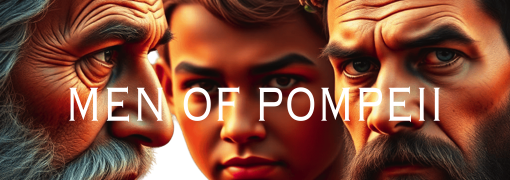To understand The Role of Freedmen in Rome’s Social and Economic Transformation, we first need to define who freedmen were. Freedmen in ancient Rome were former slaves who gained freedom through a legal process called manumission. This status granted them Roman citizenship but marked them with a distinct social identity, shaped by their servile past.
Their emergence was especially prominent during the late Republic and early Empire periods—a time when Rome experienced significant demographic shifts, urban expansion, and evolving labor structures. Freedmen became key actors within this changing landscape, influencing both social dynamics and economic activities.
For a broader understanding of this transformative period in Rome’s history, resources like Men of Pompeii offer engaging content that brings the past to life. The experiences of freedmen illuminate patterns of social mobility, economic integration, and cultural adaptation that contributed to Rome’s transformation.
Moreover, the influence of philosophical schools such as Stoicism, which emphasized living in harmony with nature and using reason, can also be seen during this period. This philosophical shift influenced the thoughts and actions of many important figures throughout the empire.
Additionally, the Roman Army played a crucial role in shaping the empire’s growth and upkeep. Its structure, strategies, and operational effectiveness were key in achieving victories across large areas.
Lastly, Roman roads, which served as the backbone of the empire, were instrumental in maintaining and expanding its territories. Exploring freedmen sheds light on often overlooked contributors to Rome’s development beyond traditional elite narratives.
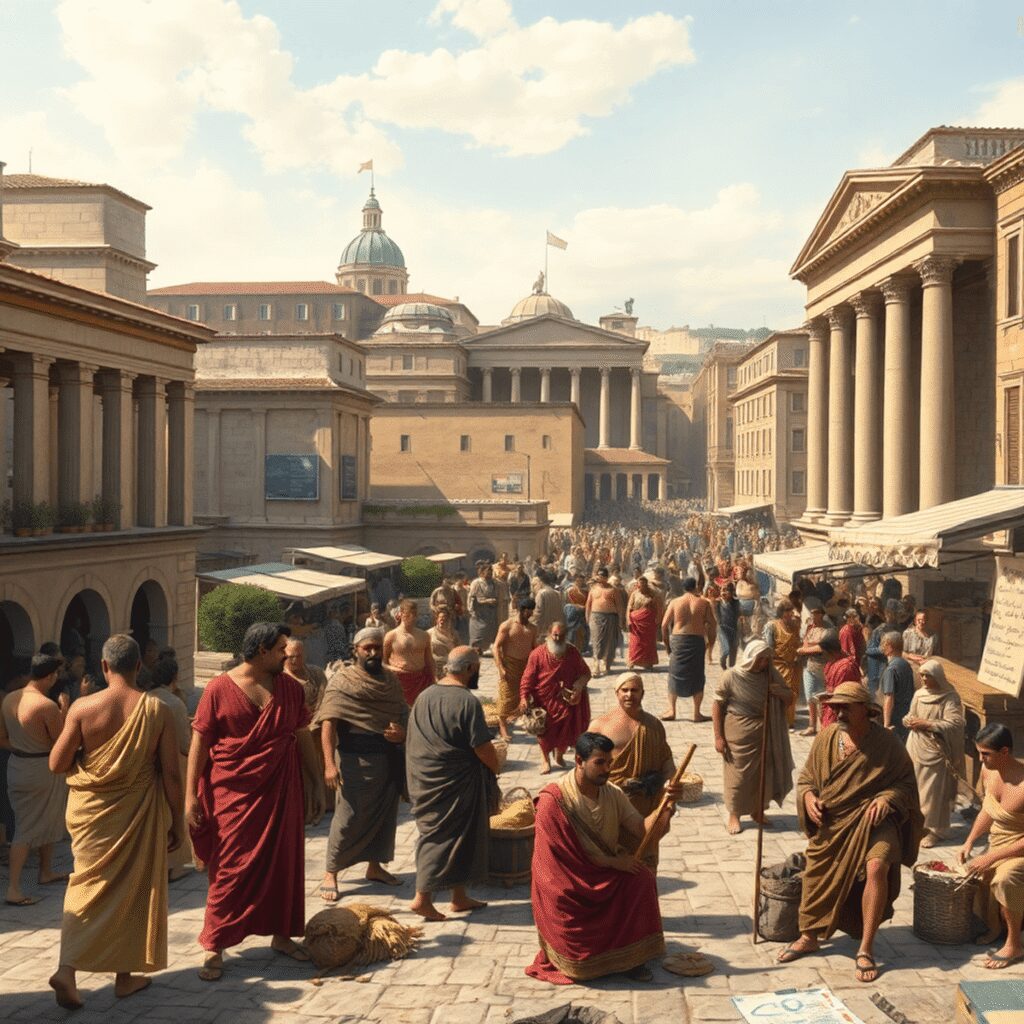
The Social Status of Freedmen in Ancient Rome
Freedmen occupied a distinct place within Roman society, shaped by a complex blend of social status, legal citizenship, and persistent stigma linked to their servile origins. Despite being granted Roman citizenship upon manumission, freedmen were often viewed as socially inferior by the freeborn elite. This dual identity—citizen yet marked by a past in slavery—created both challenges and opportunities in navigating urban life.
Integration into Urban Society
One of the primary ways freedmen integrated into urban society was through active participation in guilds known as collegia. These associations functioned as social and professional networks, providing mutual support among members who shared similar trades or social backgrounds. Freedmen gravitated toward these groups for several reasons:
- Mutual Aid: Collegia offered financial assistance during illness or death, helping freedmen manage risks they could not easily bear alone.
- Religious Cohesion: Many collegia maintained religious rites and festivals honoring patron deities, which reinforced group identity and solidarity.
- Social Networking: Through gatherings and ceremonies, freedmen expanded their social connections beyond immediate neighborhoods.
Guilds served not only economic purposes but also fulfilled important social and religious functions. They bridged gaps left by exclusion from traditional elite circles, allowing freedmen to cultivate a sense of belonging and collective identity. Membership in collegia helped freedmen assert their presence within the crowded urban fabric of Rome, fostering community ties that could translate into practical advantages like business partnerships or political backing.
The role of collegia extended beyond mere survival; they became platforms for social visibility. Freedmen could demonstrate loyalty to fellow members and patrons through participation in religious observances and public events. This visibility helped mitigate some of the negative perceptions attached to their past slavery. While freedmen rarely gained full acceptance as equals to freeborn citizens, their organized presence within collegia signaled a form of social integration that challenged rigid class boundaries.
Participation in these groups also allowed freedmen to cultivate networks essential for economic advancement. The combination of social support and professional collaboration enabled many freedmen to improve their standing over time. Engaging with guilds often marked the first step toward establishing independent households and businesses, embedding former slaves into the wider urban economy.
The intertwining of social, religious, and economic functions within collegia illustrates how freedmen negotiated their complex identities. They leveraged collective organization to transform stigma into opportunity, carving out roles that contributed significantly to Rome’s evolving urban society.
However, it is essential to note that while freedmen were forging their paths in urban society, other segments of Roman society such as the patricians, continued to dominate with their wealth and power. The patricians were usually rich landowners who held significant influence over politics and economics.
Moreover, the entertainment sector in Ancient Rome played a crucial role in shaping societal norms and relationships. Events such as gladiator games or chariot races were not merely forms of entertainment but also had significant effects on social relationships and political authority as detailed here.
The legacy of Ancient Rome remains a cornerstone of Western civilization, with its influence seen in various aspects of modern society as explored
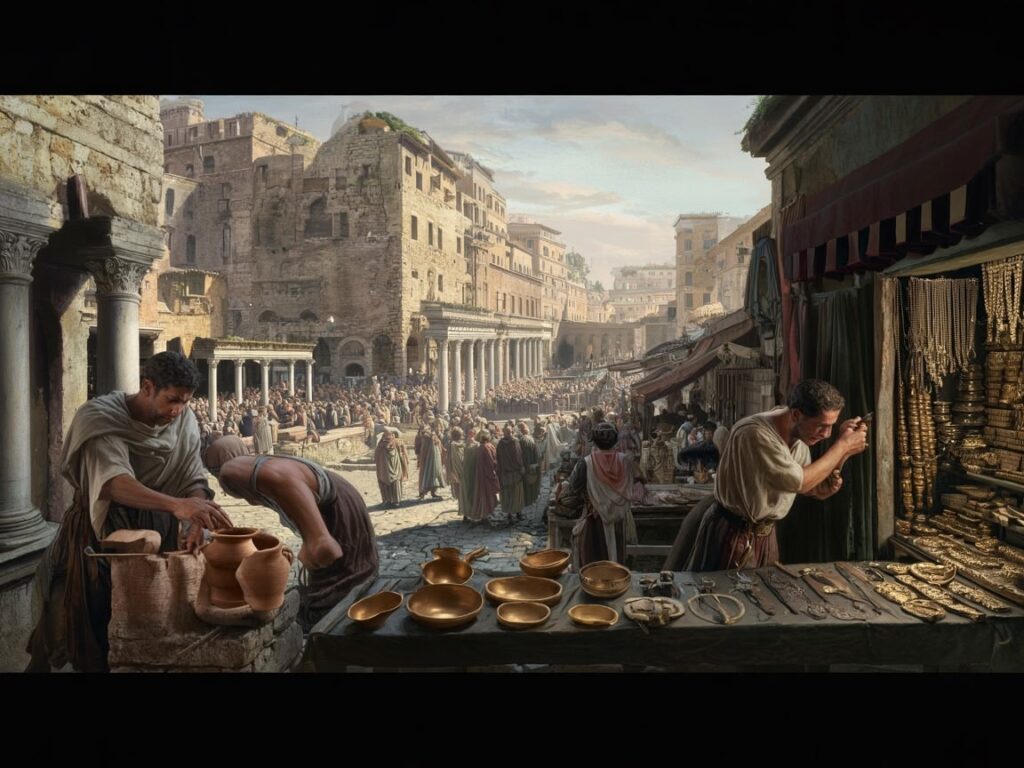
Patronage and Political Influence
Freedmen gained legal freedoms and citizenship rights through manumission, yet the persistent social stigma due to slave origins limited their full acceptance in Roman society. Their social status remained distinct from that of freeborn elites. This divide curtailed their ability to hold formal political office or participate directly in the traditional mechanisms of power.
Limited direct political power
Freedmen could not serve as magistrates or senators, roles reserved for freeborn citizens. Their influence within official political structures was minimal.
Patron-client relationships
Freedmen developed strong ties with elite Romans who acted as patrons. These networks provided access to economic opportunities, legal protections, and social advancement.
Indirect political influence
Through these patrons, freedmen could wield significant sway behind the scenes. They often managed estates, financed enterprises, or advised patrons, thereby shaping decisions and policies indirectly.
This system allowed freedmen to navigate the constraints imposed by their servile origins. Their role in guilds (collegia) and urban associations complemented these patronage ties by reinforcing community bonds and creating alternative forms of social capital. Such connections were crucial in expanding their influence despite formal limitations.
The dynamics between freedmen and elites reveal important aspects of Rome’s social transformation. Freedmen’s ability to leverage patronage networks underscores how personal relationships shaped political power beyond official titles and offices. These insights into the socio-political landscape of ancient Rome can be further explored in academic studies such as this one which delve deeper into these themes.

Economic Contributions of Freedmen
Labor Dynamics in Ancient Rome
Freedmen held a unique position in Rome’s intricate labor system, acting as a link between enslaved individuals and freeborn workers. Their role was neither completely submissive nor entirely independent, which influenced their economic functions and relationships in distinct ways.
1. Intermediate Economic Status
Freedmen had legal freedom and citizenship rights but often lacked the full privileges accorded to freeborn Romans. This placed them economically between slaves—who had no personal agency—and freeborn laborers, who enjoyed broader social protections. Freedmen’s semi-independent status allowed them to pursue trades, crafts, and small-scale commerce that slaves could not legally engage in.
2. Collaboration with Slaves and Freeborn Workers
The Roman economy relied on a fragmented labor force with overlapping roles. Freedmen frequently worked alongside slaves and freeborn laborers in various sectors:
- Agriculture: Freedmen could manage small farms or serve as overseers using slave labor under their supervision. This aspect of their role is crucial to understand as agriculture was a significant driver of Roman economic growth.
- Manufacturing: Workshops often employed freedmen as skilled artisans producing pottery, metalwork, textiles, or other goods essential to urban life.
- Construction: Freedmen contributed as craftsmen or supervisors in building projects, working with both free workers and enslaved laborers on large-scale infrastructure developments.
3. Economic Niche and Entrepreneurship
Many freedmen leveraged their skills to establish businesses or manage commercial enterprises. Their ability to operate independently distinguished them from slaves while their servile background limited access to elite commercial circles. Freedmen often specialized in trades requiring specific expertise or capital investment unavailable to slaves, such as tailoring, baking, or moneylending.
4. Labor Force Fragmentation
The coexistence of slaves, freedmen, tenant farmers, artisans, and wage laborers created a multifaceted economic network. Freedmen’s role exemplified this fragmentation—they were not merely workers but active participants shaping commerce and production in an evolving urban environment. Their dual identity as former slaves and citizens meant they could navigate between different social worlds within the economy.
This intermediate status positioned freedmen as crucial agents in maintaining the functionality of Rome’s diverse labor market. They helped sustain both the physical infrastructure of the city and the commercial activities necessary for its growth during the late Republic and early Empire periods. Understanding their contribution also sheds light on the lives of plebeians—the common people of ancient Rome—who were vital to the fabric of Roman society and represented the majority significantly influencing political and economic structures here.
Impact on Rome’s Urban Economy
Freedmen formed a crucial segment of Rome’s labor force, particularly in the fragmented urban economy. After manumission, many freedmen engaged in a variety of economic sectors that were essential to the daily functioning of the city. Their roles were diverse and included:
- Artisans: Skilled freedmen produced goods ranging from textiles and pottery to metalwork and luxury items. Their craftsmanship supported both local markets and elite consumption.
- Business Managers: Some freedmen managed commercial enterprises or workshops, leveraging their networks and expertise to oversee production and trade.
- Traders: Freedmen often operated as merchants, facilitating commerce within Rome and beyond its borders. Their participation helped maintain the flow of goods critical for urban life.
- Administrators: Freedmen served in bureaucratic positions within households or imperial offices, contributing to effective management of resources.
Their contribution extended beyond economic output. Freedmen played key roles in sustaining city infrastructure through skilled labor and specialized services such as construction, maintenance, and transportation. This involvement helped keep Rome’s urban environment functional amid rapid population growth.
The role of freedmen in Rome’s social and economic transformation highlights how these former slaves became indispensable actors within the complex web of trades and crafts that underpinned the city’s prosperity. Their integration into multiple sectors reinforced the interconnected nature of Rome’s urban economy and demonstrated their lasting impact on its development.
This intricate social structure is reminiscent of the social class divide in ancient Rome, where daily life varied significantly across different social strata. Moreover, the engineering feats achieved during this period, which included incredible Roman engineering feats, played a pivotal role in shaping the urban landscape and facilitating economic activities.
Interestingly, these historical narratives have found their way into modern role-playing games like Second Life. In such virtual environments, players can immerse themselves in detailed recreations of historical settings, such as the Romanum world explored by JP Farmer. This provides a unique blend of education and entertainment that brings ancient history to life.
In addition to these historical insights, it’s important to note that similar dynamics can be observed in contemporary societies where programs like those offered by Indego Africa aim to empower individuals through skill development and economic opportunities, echoing the transformative impact that freedmen had on ancient Rome’s urban economy.
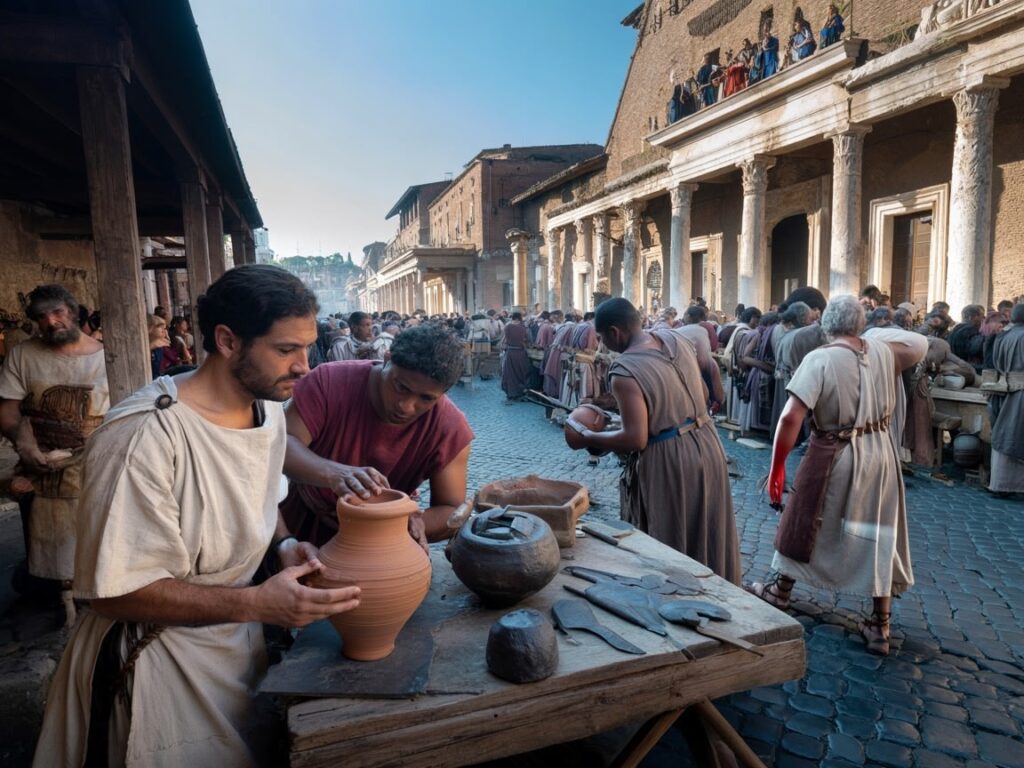
Social Mobility and Identity Challenges faced by Freedmen
Freedmen experienced a significant shift in social status when they moved from slavery to citizenship. This transition represented a notable form of social mobility within the rigid structure of Roman society. Manumission granted them legal freedom and the rights of Roman citizens, enabling access to new economic opportunities and social roles previously denied to them.
Despite this advancement, freedmen continuously faced status tensions rooted in their servile past. Their former condition as slaves left a lasting stigma, preventing full acceptance by the freeborn elite. Many freedmen sought to navigate these complexities by emphasizing loyalty and service to their patrons, adopting Roman customs, and participating actively in urban institutions like collegia.
Challenges Faced by Freedmen
- Legal citizenship did not erase social barriers.
- Freedmen were often excluded from certain political privileges.
- Their identity remained ambivalent — caught between former servitude and newfound freedom.
- Family names and patron-client relationships reinforced both inclusion and distinction.
The dual reality of being free yet socially marked shaped the identity of freedmen in profound ways. They carved out spaces for themselves but had to constantly manage perceptions tied to their past. This struggle influenced personal ambitions, community affiliations, and economic strategies as freedmen negotiated their place in Rome’s evolving social landscape.
While the legal status afforded by manumission was a significant step forward, it did not come without its complexities. The legal status of Roman women also reflects a complex interplay of rights and restrictions that significantly influenced gender dynamics in ancient Rome. Understanding this intricate legal framework is essential for grasping the broader socio-legal context that shaped the experiences of both freedmen and women in ancient Rome.
Moreover, it’s crucial to recognize that the principles of Roman law, which originated in ancient Rome around 753 BCE, have played a pivotal role in shaping modern legal systems. This legacy continues to influence various legal systems today, providing valuable insights into the foundations of contemporary laws.
Conclusion
The role of freedmen in Rome’s social and economic transformation reveals critical insights into the complexities of Roman society. Their journey from slavery to citizenship highlights key themes of social mobility, identity negotiation, and the interplay between legal status and societal acceptance. Freedmen contributed significantly to urban economies, labor dynamics, and social networks, shaping Rome’s development during pivotal historical periods.
Their legacy challenges traditional narratives focused solely on elite figures, emphasizing the importance of diverse social actors.
Understanding freedmen’s experiences enriches our comprehension of Rome’s transformation impact beyond politics and military conquests.
Further research into freedmen and other marginalized groups promises to deepen knowledge about the nuanced realities of ancient Roman life.
You can explore the freedmen legacy to uncover how these former slaves helped redefine urban society, contribute economically, and subtly influence political structures. Their story remains essential for appreciating the full scope of Roman history. The twelve tables, a significant milestone in the development of Roman law, played a crucial role in shaping the legal landscape that affected freedmen’s societal acceptance.
Moreover, understanding the structure of power during the Roman Republic provides valuable context on how freedmen navigated their new roles in society. The political landscape was complex and influenced by various factors including military conquests led by figures like Scipio Africanus who changed the course of history through his strategic victories.
Furthermore, exploring ancient Roman religion reveals how deeply intertwined religious practices were with every aspect of Roman life including politics and social structures. This understanding adds another layer to comprehending the multifaceted reality of ancient Roman life.
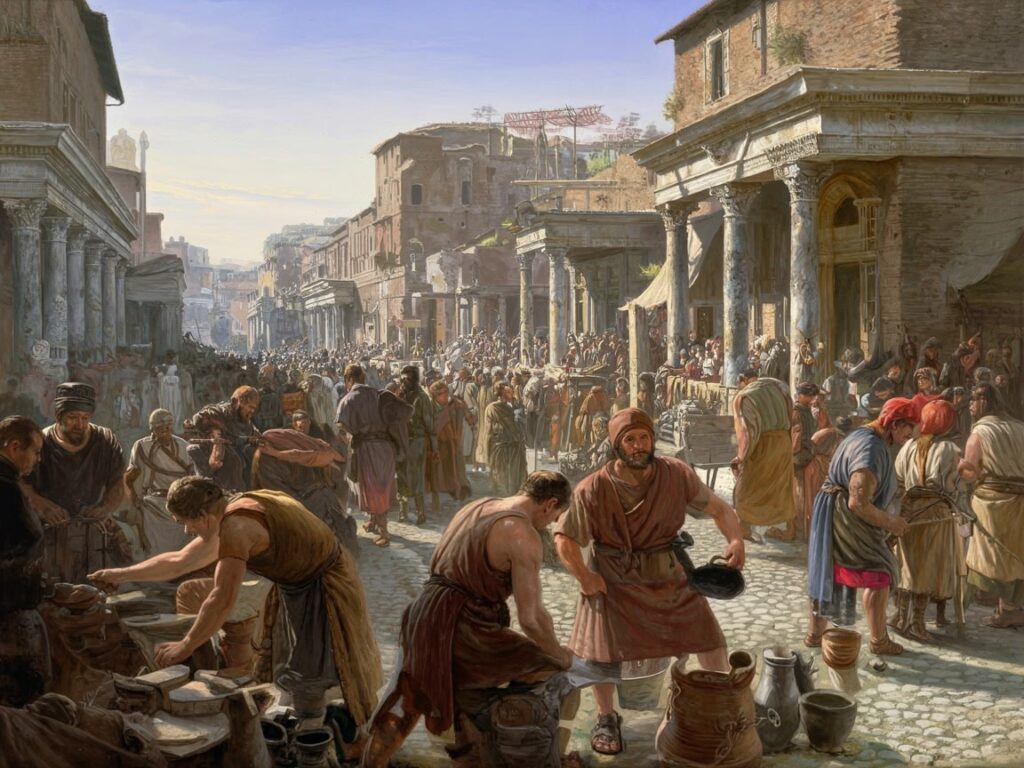
FAQs (Frequently Asked Questions)
Who were the freedmen in ancient Rome and what was manumission?
Freedmen in ancient Rome were former slaves who had been granted freedom through a legal process called manumission. This process allowed them to transition from servile status to becoming Roman citizens, playing a significant role during the late Republic and early Empire periods.
What was the social status of freedmen in Roman society?
Despite gaining legal citizenship and freedoms through manumission, freedmen faced persistent social stigma due to their servile origins. They occupied a unique social position between slaves and freeborn citizens, often integrating into urban society through guilds (collegia) and community associations that provided mutual support and social cohesion.
How did freedmen integrate into urban society in ancient Rome?
Freedmen integrated into urban society by joining collegia and guilds, which served both social and religious functions. These organizations helped freedmen build community presence, establish networks, and gain mutual support within the complex social fabric of Roman cities.
What economic roles did freedmen play in Rome’s economy?
After manumission, freedmen actively participated in various economic sectors including agriculture, manufacturing, construction, trades, crafts, commerce, and administration. They contributed significantly to sustaining the urban economy by providing skilled labor, managing businesses, trading goods, and producing essential items for daily life.
Did freedmen have political influence in ancient Rome?
Freedmen had limited direct political power due to social stigma and restrictions from freeborn elites. However, they accessed opportunities through patron-client relationships with Roman elites, allowing them indirect political influence via these patronage networks.
What challenges did freedmen face regarding social mobility and identity?
Freedmen experienced ongoing tensions balancing their servile past with their new legal status as citizens. While manumission offered a form of social mobility from slavery to citizenship, freedmen often struggled with acceptance among freeborn elites and navigated complex identity challenges within Roman society.

